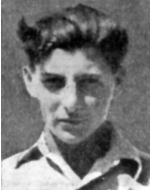Shwartz, Mordechai (Mickey)
Mordechai, son of Roza and Shmuel-Alexander, was born in 1926 in Czechoslovakia, in the town of He – Chichiri, who was educated in an elementary school up to eighth grade and in accordance with family tradition and the will of his parents. The Czechoslovak Republic came to an end after the signing of the Munich Agreement in September 1938, even before World War II: Slovakia gained independence and became a German Protectorate, and Nazi Germany invaded the Czech Republic in March 1939 and Hitler declared a “Protectorate” A German minority: Bohemia and Moravia The Hungarian army invaded the southern parts of the country and the fate of the Jews was similar In the early years of 1944, after Germany occupied Hungary, the Jews were also concentrated and sent to the camps, and by the end of the war some 200,000 Jews died, two of them Jews, A third of the Jews of Czechoslovakia were killed on the eve of the war, and Mordecai’s parents were taken to a detention and extermination camp, where he was saved by a Hungarian Hungarian driver who worked for his father. During those years, until the end of the war, Mordechai worked as a coachman. At the end of the war Mordechai, who had no relatives in his native country, decided to immigrate to Palestine. As a member of the “Young Maccabi,” he joined a group of members of his movement who sailed to Israel from Italy aboard an illegal immigrant ship, apparently “Dalin”. Upon their arrival on the shores of Palestine, on September 2, 1945, they were interned in the British detention camp at Atlit. In the mid-1940s the camp in Atlit contained hundreds of immigrants. In October 1945, as part of its struggle against the British immigration restrictions, the Haganah decided to break through the camp and release its prisoners. For this purpose, several camouflaged Palmach fighters infiltrated the camp and organized contact with the Jewish policemen who were among the guards of the camp. The British police called the scene and tried to stop the escapees, but the escapees managed to outsmart them with the help of thousands of Jews from Haifa and the surrounding area, who wandered in the open and helped block the British policemen. Some 200 prisoners in the Atlit camp managed to escape that night, and after an exhausting night journey accompanied by Palmach fighters, they reached Kibbutz Yagur and Beit Oren, where they dispersed among the Jewish communities in the country. As a member of the Haganah, Mordechai was recruited at the outbreak of the War of Independence and was attached to the 8th Battalion of the Negev Brigade – Brigade No. 12 In July 1948, he participated in a battle in Hulikat in Operation Death to the Intruder The “Ten Days” campaign initiated by Israel in July 1948, following the first truce in the war, aimed at repelling the Arab invasion forces from the country, was carried out in the Negev by Operation “Death to the Intruder.” The operation was intended to stop the well- (18.7.1948), in an attack on an Egyptian outpost in Huliqat (now the Heletz region), the Israeli forces encountered strong resistance, suffered heavy losses and failed to conquer the area, and the road to the besieged Negev was opened three months later , During the “Yoav” operation in October 1948. Mordechai was twenty-two years old when he fell. AHala was considered missing. A few months later, when the road to the Negev was breached and the Egyptians were driven away, a mass grave was discovered near the police station of Hulikat. The bodies of Mordechai and his comrades were transferred to Kibbutz Ruhama and buried there. On the 26th of Tammuz 5766 (26.6.1950) Mordechai was transferred to eternal rest in the military cemetery in Kfar Warburg. This hero is a “last scion”. The survivors of the Holocaust are survivors of the Holocaust who survived the last remnant of their nuclear family (parents, brothers, sisters, sons and daughters) who experienced the Holocaust in the ghettos and / or concentration camps and / or in hiding and hiding in territories occupied by the Nazis and / Or in combat alongside members of the underground movements or partisans in the Nazi-occupied territories who immigrated to Israel during or after World War II, wore uniforms and fell in the Israeli army.
